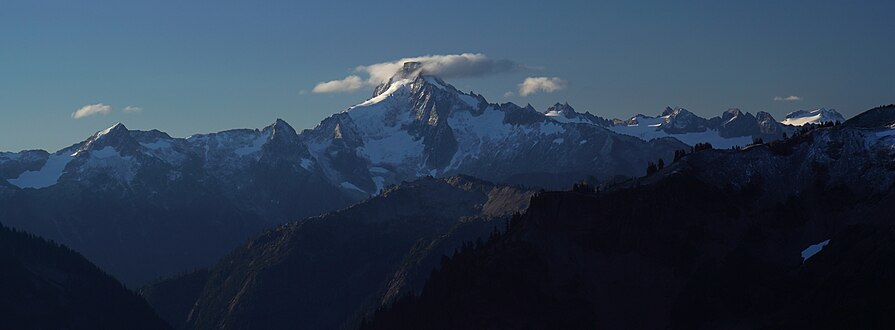Mount Blum
| Mount Blum | |
|---|---|
Washington U.S.
| |
| Parent range | Cascade Range |
| Topo map | USGS Mount Blum |
| Geology | |
| Age of rock | 15,000 years |
| Volcanic arc | Cascade Volcanic Arc |
| Climbing | |
| Easiest route | Rock/ice climb |
Mount Blum, or Mount Bald,
Six small glacial-fed tarns, called the Blum Lakes, occupy successive bowls on the southeast side of the mountain. Several other ice sheets are spread across cirques and basins on Mount Blum and neighboring peaks.[5] Blum Creek, a stream named for the mountain, drains north and west off Mount Blum and flows into the Baker River, which in turn flows into the Skagit River. The Baker Lake reservoir, one of a series of reservoirs that impound the lower Baker River, touches Mount Blum at its far northeastern segment. Lonesome Creek and Scramble Creek also drain valleys east and north of Mount Blum, respectively. Steep cliffs and drop-offs in the valleys produce some extremely tall waterfalls, such as 1,680-foot (510 m) Blum Basin Falls.
Skiing is an occasional activity on the slopes of Mount Blum.[6] Despite the popularity of the sport, Mount Blum is nearly surrounded by trail-less wilderness, except the southern ridge that connects to Mount Hagan.
Mount Blum is composed of extremely firm granite. This intrusion is common throughout the range, and is much stronger than the looser rock that makes up Mount Shuksan and the Picket Range.
Nearby mountains
Climate
Mount Blum is located in the
Geology
The North Cascades features some of the most rugged topography in the
The history of the formation of the Cascade Mountains dates back millions of years ago to the late
During the Pleistocene period dating back over two million years ago, glaciation advancing and retreating repeatedly scoured the landscape leaving deposits of rock debris.[9] The U-shaped cross section of the river valleys is a result of recent glaciation. Uplift and faulting in combination with glaciation have been the dominant processes which have created the tall peaks and deep valleys of the North Cascades area.
Gallery
-
Mount Blum seen from Copper Ridge
References
- ^ a b "Blum". NGS Data Sheet. National Geodetic Survey, National Oceanic and Atmospheric Administration, United States Department of Commerce.
- ^ "Mount Blum". Peakbagger.com. Retrieved 2009-03-17.
- ^ "Mount Blum". Geographic Names Information System. United States Geological Survey, United States Department of the Interior.
- ISBN 978-0-89886-423-6.
- ^ "Mount Blum". SummitPost.org. Retrieved 2009-03-17.
- ^ "The Baker River Smorgasbord". skisickness.com. Retrieved 2009-03-17.
- ^ Beckey, Fred W. Cascade Alpine Guide, Climbing and High Routes. Seattle, WA: Mountaineers Books, 2008.
- ^ a b Beckey, p. 16
- ^ a b c d Kruckeberg, Arthur (1991). The Natural History of Puget Sound Country. University of Washington Press.

